#enneagram triads
Text
Enneagram system
A rewrite/more in depth post of the Enneagram system compared to my last post on it. Not an expert. May change later.
If you like kpop and typology, check out my blog. I do type analysis on idols and typology notes.
___
What is Enneagram?
I mainly took notes from Riso Hudson theory.
A typology system that categorizes personalities into 9 different types. Each type is numbered from 1 - 9.
Each type has a desire and fear that motivates their actions in life.
Core and Wings
Core: Our main type. It is the foundation of our personality and does not change.
Wing: Acts as a complement to our core. Wing can be one of the two types that sit beside core type. E.g a core 2 can have a 1 wing (2w1) or 3 wing (2w3). But is not necessary to use since wings can change and/or can be balanced.
Levels of Development
Summary of healthy - unhealthy levels of personality
- Healthy levels -
Level 1: Liberation
Let go of self image so we are free to express ourselves however we want. Self acceptance of all traits.
Level 2: Pyschological Capacity
Begin to identify with positive qualities in our personalities and learn to improve ourselves with them.
Level 3: Social Value
Still strongly identify with our set self image and make effort to maintain image. Want to share our good talents and abilities to make a positive effect on self and others.
- Average levels -
Level 4: Imbalance/Social roles
Idealization of self image; have a major focus on either good or bad qualities, no in between. Fear is an obstacle here.
Level 5: Interpersonal Control
Insist on self image being accepted by others, which can cause conflict. Can lead to controlling and manipulation.
Level 6: Overcompensation
Overcompensate due to underlying negative feelings. Desperate for others' acceptance.
- Unhealthy levels -
Level 7: Violation
Desperation for acceptance leads to violation of one's self and others. Serious conflict can occur. May victimize themselves to excuse offensive actions.
Level 8: Obsession and Compulsion
May be overly obsessed with an image of who they want to be. Deceives others
Level 9: Pathological Destructiveness
Most unhealthy state, display very toxic traits and behaviours, may have mental breakdown
Disintegration vs Integration
Or basically Stress vs Growth
Disintegration: When under heavy amounts of stress, a type will go into their disintegration type. They will pick up the negative traits of that type and act like the unhealthy version of it.
Integration: When maturing/developing positively, a type will go their integration type. They will pick up the positive traits of that type and improve their character.
___
* I will only give short descriptions for the triads. I will explain more in depth in individual posts.*
Centers of Intelligence
There are 3 centers of intelligence. Each center shows how and why we solve issues in life.
Gut/Instinct/Anger (types 1, 8, 9)
Gut center focuses on reacting and taking action immediately. This triad has an issue with control and anger.
1: Often perfectionists who repress their anger in order to remain morally good. They see their anger in a negative light.
8: The most open and comfortable with their anger. Uses it to assert boundaries, especially since this type fears vulnerability.
9: Often a passive type that dismisses or downplays their anger. They fear conflict and may worry being more assertive will cause a negative effect on themselves and others.
Heart/Image/Shame (types 2, 3, 4)
Heart center focuses on self identity and connections. This triad wants love and recognition and do what they believe is best to get that. They struggle with self worth.
2: They want to be needed and helpful to others. Pride themselves on being of service. Wants to receive love and to give love.
3: The most image oriented type. They always try to show their best selves and best efforts in order to seem admirable. Fears being worthless.
4: Wants to create a unique image for themselves, believes being boring will make them unloveable.
Head/Thinking/Fear (types 5, 6, 7)
Head center focuses on ideas, making rational decisions, and gathering info. This triad deals with fear and uncertainty.
5: The most internalized head type. 5's want to gather as much knowledge and resources as possible in order to stay secure and independent.
6: Quite an anxious type who seeks security through relations with others.
7: This type fears pain and suffering and seek out experiences in order to avoid negativity.
___
Other triads
- Harmonic Triads -
How types handle conflict, coping mechanism
Reactive (4, 6, 8)
Reactive types are not afraid to show and speak about their true feelings. They may seem "dramatic" in a way.
4: Melodramatic and self absorbed in negative feelings, drowns in intensity
6: Will argue, stick up for the right thing, moody, anxious
8: Big and loud reactions, can be very fiery
Positive (2, 7, 9)
Positive types dislike negativity and conflict and have their own ways of avoiding such tension. Optimistic during hard times.
2: Actively tries to be a good and kind person, only tries to focus on the good aspects of people
7: Seeks out fun opportunities to make their life exciting (basically distraction)
9: Values harmony and peace, will not risk any type of action that will disturb these values
Competency (1, 3, 5)
Competent types are often perfectionists who want to show their best selves. Objective and rational.
1: Strives to be correct and right, wants to be precise in what they do
3: Represses softer emotions to keep up a certain image, thrives with work/passions so they can be the best at what they do
5: Detached from feelings to remain logical and objective, knowledge seeking
- Hornevian Triads -
Relationships with others, how they get what they want
Assertive (3, 7, 8)
Assertive types go against people to get what they want. Do not back down easily, can seem aggressive and forceful.
3: Pushes through obstacles for achievements, goal oriented
7: Asserts their right to have fun, refuse to be restricted
8: Asserts power and strength, places boundaries
Withdrawn (4, 5, 9)
Withdrawn types are very internalized and do not show their needs openly. Deals with things alone.
4: Feels something is wrong with them internally, feels misunderstood
5: Detached from others as to not drain their own energy, will figure it out themselves
9: Introspective, lets life happen
Compliant (1, 2, 6)
Compliant work with people to get what they want. Builds relationships for security, wants to be helpful to others.
1: Doing the right thing instead of one's own wants
2: Focus on other's needs more instead of self
6: Tries to build a safe and secure environment by getting ppl to work together
- Object Relations -
How we are affected by others, our own affect on others, how we react to personal wounds
Attachment (3, 6, 9)
Seek out bonds and companionships for particular reasons. Individuality vs adaptation.
3: Changes their image to suit whoever they are with in order to meet expectations
6: Creates support systems to help with their self doubt and indecisiveness
9: Adapts to the energy of the environment to keep harmony
Frustration (1, 4, 7)
Triad gets frustrated when their needs aren't met.
1: Has a need to improve every little imperfection they find
4: Dislikes shallowness, longs for depth and complexity
7: Not enjoying experiences, not feeling fulfilled
Rejection (2, 5, 8)
Their own needs feel unimportant to others, so they reject their own needs as well.
2: Rejects the need to receive love and guidance, instead focuses on connecting with others and helping them.
5: Ignores and minimizes all their needs, offers knowledge and expertise in some hope of being acknowledged for their intelligence.
8: Rejects by being never putting their guard down, wanting to appear strong and as the protector of others.
___
Subtypes
Claudio Naranjo theory
There are three subtypes/instinctual variants that show our drive in life. There are 27 different subtypes in total.
Self Preservation (Sp)
Focuses on physical safety and security. Our physical health, financial security, obligations, and comforts.
Sexual/One - on - one (Sx)
Wants intensity and deep connections, one on one relationships are preferred.
Social (So)
Prefers to be in a community, wants to create good connections and bonds with others. Socially aware, focus on group goals and contributions.
___
Tritype
Katherine Fauvre theory
A minor but still interesting piece of Enneagram. Tritype is formed of your 3 dominant types from each center. The first number will always be your core, followed by your other 2 dominant types.
E.g 369. 3 = core, heart. 6 = head. 9 = gut.
___
Enneagram notes
___
Side blog:
Kpop astrology @rainy-astrology
Kpop fanarts @rainy-artworks
#enneagram#enneagram types#typology#mbti#enneagram notes#tritypes#triads#enneagram triads#instinctual variants#subtypes#enneagram personality#personality theory#enneagram 1#enneagram 2#enneagram 3#enneagram 4#enneagram 5#enneagram 6#enneagram 7#enneagram 8#enneagram 9#integration#disintegration#stress#growth
98 notes
·
View notes
Text
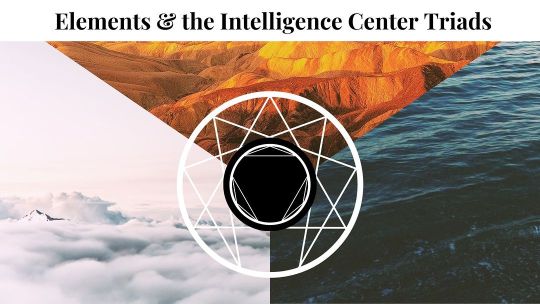



Elements & the Intelligence Center Triads, by Stephanie J. Spencer.
Earth & The Gut Center Triad
Enneagram Types 8, 9, & 1
Priorities: comfort, independence, energy, autonomy
Struggles: anger and control
Strengths: serenity, strength, groundedness
Characteristics: protecting, resisting, connecting, feeling
Water & The Heart Center Triad
Enneagram Types 2, 3, & 4
Priorities: identity, emotion, relationship, image
Struggles: sadness and shame
Strengths: authenticity, compassion, creativity
Characteristics: praising, empathizing, connecting, feeling
Air & The Head Center Triad
Enneagram Types 5, 6, & 7
Priorities: logic, security, preparation
Struggles: fear and overthinking
Strengths: synthesis, clarity, planning, competency
Characteristics: observing, researching, supporting, conceptualizing
4 notes
·
View notes
Text
9s
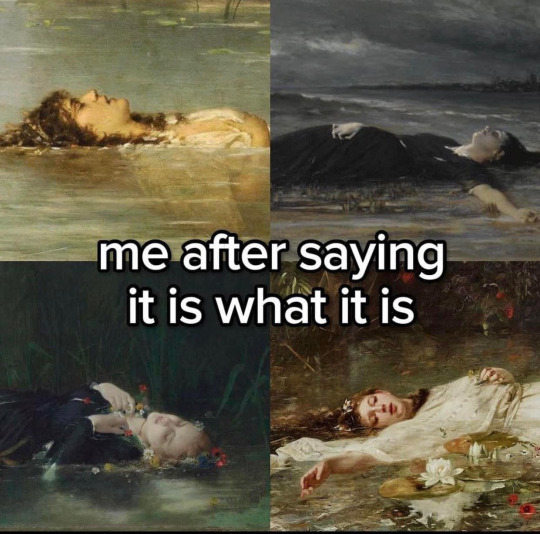
#enneagram 9#9w8#9w1#type 9#typology#enneagram#personality theory#8w9#1w9#withdrawn triad#optimist triad#positive triad#attachment triad
95 notes
·
View notes
Text
The thing about nines is that they will never seem mad. And that's because they never "feel" mad. They suppress it until they don't even register it.
But once you unlock all that anger (and that takes a lot), you do not want to stand in their way. Nines heal and comfort people. It's what they do best. But in order to know how to build you up, they have to know how to destroy you, too.
It goes against every one of their morals to do so. But if you push them past their limit, they will send you to hell on earth.
Watch out for nines. They may seem mellow, but they're pretty intense when it gets down to it.
#enneagram#enneagram 9#enneagram nine#type nine#let's talk more about nine anger#they're in the anger triad but everyone just wants to talk about their passion#which is sleeping and procrastinating#which is true#but it bugs me#we're not all dreamers#we can just as easily become assassins#we'll hate every second of it#it's not natural for us to do that#but#if we have to#then we will
23 notes
·
View notes
Text

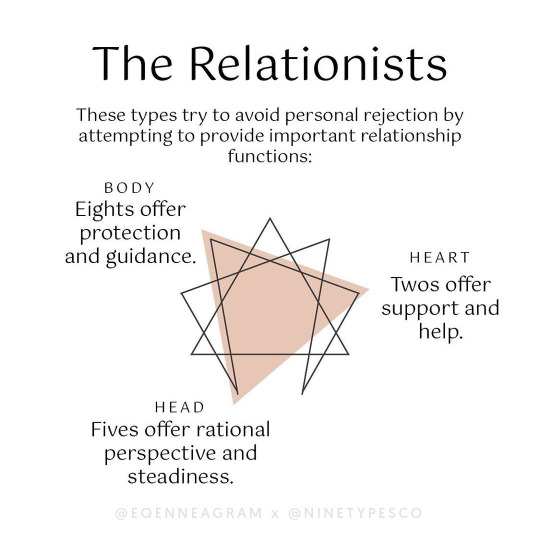
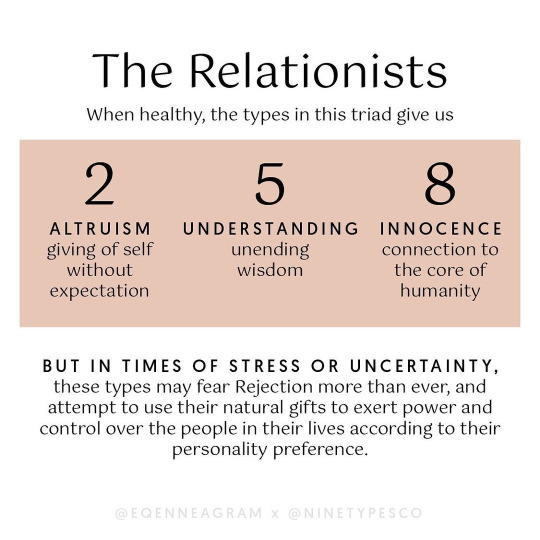

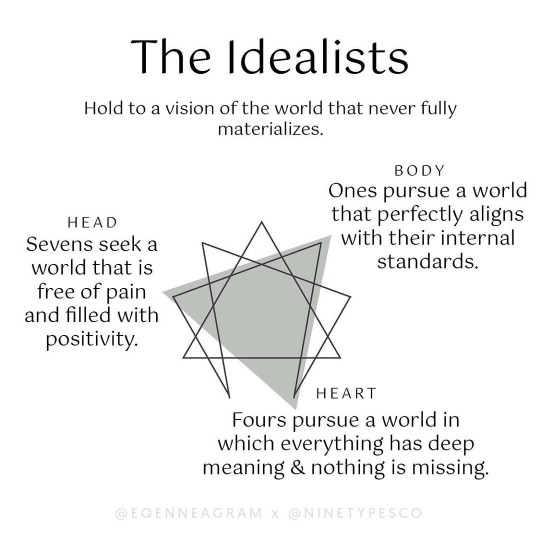

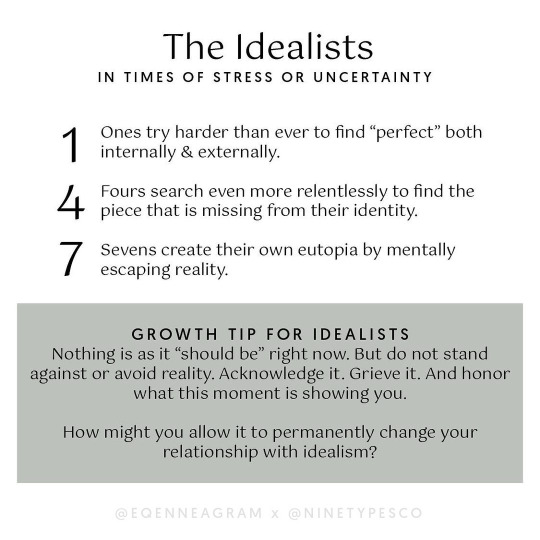

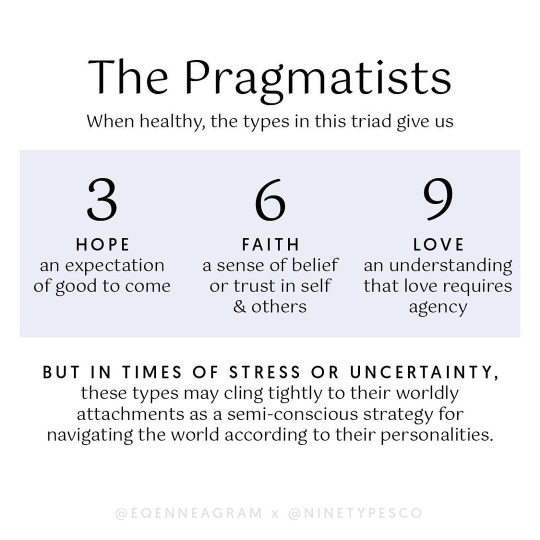
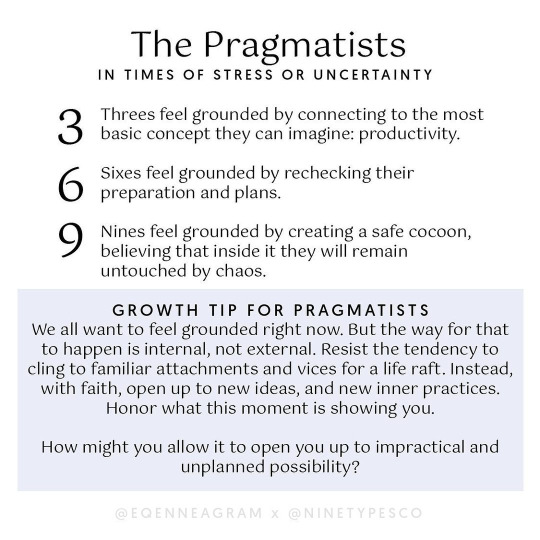
Relating to the World in a Time of Uncertainty: The Harmony Triads. From NineTypesCo by Steph Barron Hall.
This concept is called Harmony Triads. They are represented by equilateral triangles overlaid over the Enneagram symbol so that each triad includes one heart type, one head type, and one body type.
The Harmony Triads explain how each Enneagram type interacts with the world, and they can be especially helpful when navigating uncertainty. Any time we uncover a new way of looking at the Enneagram, we can find that there is something more to learn about ourselves and those around us.
#enneagram 1#enneagram 2#enneagram 3#enneagram 4#enneagram 5#enneagram 6#enneagram 7#enneagram 8#enneagram 9#harmony triads#the relationists#the idealists#the pragmatists#steph barron hall#ninetypesco#enneagram
10 notes
·
View notes
Text
Enneagram Defense Mechanisms - The Head Triad
Defense mechanisms part 2 - part 1 on the gut triad is linked here.
E5: Isolation
Isolation is a defense mechanism in which one cuts themselves off from others for periods of time. Isolation can be separated into 3 categories; physical, mental, and emotional. Physical isolation is the easiest to recognize, and is simply being alone. Mental isolation presents itself as zoning out, like their mind is elsewhere. They're physically present, but mentally occupied. Emotional isolation can be likened to emotional detachment; one will cut themself off from emotions and will refuse to get involved with others emotionally. The 5's use of isolation stem from their (often unconscious) need to avoid feeling drained. As a part of the head triad, the 5 desires security, and they feel they must be very careful with how they use what little energy they have so that they don't run out. Being present - physically, mentally, or emotionally can often feel exhausting, so they avoid it altogether. Ridding themself of "unnecessary" strain on their energy reserves leaves them free to use direct their energy towards security; though often knowing they have extra energy should they need it is also a form of security the E5 desires, which is another reason they isolate.
E6: Projection
Projection is a defense mechanism in which one will attribute emotions, motivations, attributes, or behaviors of their own that they (unconsciously) feel are unacceptable onto another entity - be it a person or a group. These may not necessarily be negative; they may be neutral, or even positive. The E6's use of projection stems from the unconscious desire to allay their internal fears and anxieties and avoid rejection. Through projecting, the 6 avoids situations they would prefer not to engage in and protects themselves from rejection. For example, they might say that they don't think the other person is ready to talk about something when in reality, they themselves are not ready to talk about it; in this instance, they fear they will be abandoned (as is the 6's basic fear) if they confront the situation, so they ascribe the hesitance to address the situation that they are feeling onto the other, which ensures they both do not have to have an unwanted conversation and are not risking being abandoned. The 6 also uses projection to justify internal fears and anxieties. They might be anxious people will betray them, so they project that anxiety onto someone in order to legitimize their fear. In this manner, they almost preempt rejection in (unconscious) hope of ensuring that they will not be as hurt by it.
E7: Rationalization
Rationalization is a defense mechanism in which one attempts to avoid the true reasons for their behavior or emotions by explaining it in a seemingly logical manner. The 7 (unconsciously) uses rationalization to avoid painful emotions. They attempt to reframe the situation positively and explain away or justify things in order to distance themself from painful feelings. This can look like minimizing the issue ("I didn't want it that badly anyways, it's no big deal") or making excuses ("it was going to end well anyways"), to name two examples. Rationalization does not necessarily have to be about one's own emotions or behavior; it can also come in the form of making excuses or trying to reframe another's actions. As a part of the head triad, the 7 desires security. They are always on the go, flitting from one thing to the next in hopes of gaining that security, using rationalization to avoid painful emotions that might bring them down.
#enneagram#enneagram 5#enneagram 6#enneagram 7#head triad#defense mechanisms#the enneagram as according to my understanding#enneagram defense mechanisms
21 notes
·
View notes
Text
HPHM MC PERSONALITY ASKS
Does anyone else think it’s fun to take personality tests and inventories as their MC? Here’s a bunch of them. Please note that some are not the official version, but they should be free and accessible. I wager they’re accurate enough. Also, some tests may take a while, but don’t take it too seriously!
And yes, I am a psychology major…
———
[1.] What is their Top Love Language? (acts of service, quality time, receiving gifts, words of affirmation, physical touch) https://5lovelanguages.com/
[2.] What is their D&D alignment? http://easydamus.com/alignmenttest.html
[3.] What is their highest Big Five personality trait? (openness, conscientiousness, extraversion, agreeableness, neuroticism) https://bigfive-test.com/
[4.] What is their Four Temperaments test result? (sanguine, choleric, melancholic, phlegmatic) https://openpsychometrics.org/tests/O4TS/
[5.] What is their Enneagram result? https://www.truity.com/test/enneagram-personality-test
[6.] What is their Myers-Briggs Type Indicator (MBTI) result? https://www.16personalities.com/free-personality-test
[7.] Which Freudian defense mechanism do they most often use? https://psychologia.co/defense-mechanisms/
[8.] What is their HEXACO result? http://hexaco.org/hexaco-online
[9.] What is their Minnesota Multiphasic Personality Inventory (MMPI) result? https://www.idrlabs.com/multiphasic-personality/test.php
[10.] Where do they fall on the Multidimensional Introversion-Extraversion Scales (MIES)? https://openpsychometrics.org/tests/MIES/
[11.] What is their Fisher Temperament Inventory (FTI) result? https://openpsychometrics.org/tests/FTI/
[12.] What is their Short Dark Triad (SD-3) test result? https://openpsychometrics.org/tests/SD3/
[13.] What is their True Colors test result? https://www.idrlabs.com/true-colors/test.php
[14.] Where do they fall on the Kinsey Scale? https://www.idrlabs.com/kinsey-scale/test.php
[15.] What is their 16 Personality Factors (PF) result? https://openpsychometrics.org/tests/16PF.php
[16.] Where do they fall on the Zodiac-sign Association Personality Scales (ZAPS)? https://openpsychometrics.org/tests/ZAPS/
[17.] What is their DISC personality test result? https://openpsychometrics.org/tests/ODAT/
#fireandfolds' hphm ask list#personality asks#mbti#dark triad#kinsey scale#d&d alignment#hexaco#four temperaments#enneagram#freudian defense mechanisms#hphmseojunglee#ask list#oc ask list#hogwarts mystery ask#hogwarts mystery ask list#hphm ask list#hphm asks#hphm#harry potter hogwarts mystery#hogwarts mystery#hogwarts mystery mc#hphm mc ask list
66 notes
·
View notes
Text
Social styles: rejection
Rejection types are focused on staving off rejection, which is why they take a power stance. Since they’re limited in terms of relating to other people, they have preset parameters for interaction. Others basically need to fill these slots.
This is tied to the neurosis with regard to their own needs. Depending on the situation, they’ll do mental acrobatics such as ignoring, denying, or burying their needs. So they meet their needs on their own, and when cooperation is needed they’ll deny their needs and go “I didn’t need it anyway”. Cutting off and walking away.
The underlying belief is that someone who “doesn’t need xyz” is essentially invulnerable. An invulnerable person can’t possibly be rejected. Cutting off/walking away is seen as affirming one’s independence. The paradox is that a lot of energy gets poured into “detachment”, ending up in anti-dependence rather than independence.
40 notes
·
View notes
Text
Isolation and Mistyping
A question came up recently about the notion of isolation in the types. A feeling of separateness and focus on personal uniqueness/social deviance is often attributed to types such as 4 and 5 a bit excessively. In reality, the vast majority of people see themselves as individual and separate from others and can fixate on this in both positive and negative fashion. 9, 6, and 3 are especially inclined towards this, but for 9 it becomes at times more difficult to distinguish because of the fact that they are also part of the withdrawn triad. This leads the majority of 9s, especially those who have faced social isolation or any form of rejection, to mistype as 4 or 5.
9 is a type that goes back and forth between the desire for autonomy/"that place where they can just exist and be" that comes with being a withdrawn gut type and the desire to connect and align that comes with being an attachment type (which, due to how that sort of desire is interpreted culturally, is typically not recognized consciously as much). As much as 9 in the withdrawn sense wants to be separated, unaffected, and and that option to be alone, they rarely want to be fully and truly isolated or disconnected. Part of why 9 falls asleep is because it is trying to get both of these things and the methods that they use disconnects them from reality, putting them asleep to their life. When 9s do get into the position where they are consistently rejected or actually isolated, they do tend to fixate on it and are often really not super happy with that because there is an unconscious desire to have some form of connection in the attachment sense. 9 doesn't constantly want to deal with the resistance that that causes or loose the access to the things they want that comes with having that isolation, so they can really fixate on that feeling of isolation and segregation from society when it happens. There can in general focus on areas where they are segregated from that they want access to. And they can align with the segregated image as well, kind of like the concept of the cp6 does where it seems to be pushing away or taking pride in that segregation. They can even be consciously very prideful of this. But that alignment is still very 9, attachment, and common among 9s in isolated positions
5 and 4 are a bit different in that there's this arrogance instead. 4, regardless of whether or not it actually has anything irl that is pushing it away or genuine isolation specifically is trying to be segregated. There's the "oh woe is me" that comes with the 4 that may whine about being misunderstood, but their whole self conception is shrouded in that they are deep and inaccessible and that the external is at fault for being too shallow. 4 takes a certain pride in being disturbing or off-skew and even when they are not will push to be or to find depth in a world that seemingly doesn't have it. Don't get me wrong, 4s probably seek connection as well in a fantastical sense but it's with like depth or an abstracted landscape of people who give them or connect them with depth. 5 thinks people are not capable of seeing and investigating what they can, problems isolation would come from that. They are autonomy seeking and reject influence of any kind. The 5 sentiment when yearning for connection is this desire to be understood, this desire for others to see and to be aware and to have that mutual understanding if anything. They are not looking to connect or be part of things and automatically view themselves as separate and uninfluenced so it's less of a fixation, more of a "why aren't they seeing that?"
72 notes
·
View notes
Text
hi :) i think i found a good way to determine one’s heart fix (or heart type if it’s your core). i’d post this to reddit, too, but i don’t wanna deal with mistyped 4s yelling at me sooo we’ll just post it here for now.
ofc if you are one of these types and feel it could be represented better, let me know!
2 - I want to be seen as helpful and loving so people will like me. I want to be needed by the people I care about. Secretly, I want to be loved for who I am and not what I provide. I'm afraid of being alone and unloved.
3 - I want to be seen as successful and accomplished so people will value me. I want people to approve of me. Secretly, I want to be loved for who I am and not just my achievements or the roles I play for others. I'm afraid of failure and being worthless.
4 - I want to be seen as mysterious and interesting so people will approach me. I want to be seen for who I am on the inside. Secretly, I want all of me to be loved for who I am and not just the unique or intense parts. I'm afraid of being ordinary and having no personal significance
39 notes
·
View notes
Text
enneagram vibes
heart triad: insecure
head triad: avoidant
gut triad: leave me tf alone
#enneagram#analysis#no i am not becoming a typology blogger again but this is like basic enneagram theory you need to learn if you ever get into it#if you are typing yourself the best thing is to start with triad FIRST and then move to actual typing#heart triad core emotion: shame#head triad core emotion: fear#gut triad core emotion: rage#god i want to make a post about it someday but gguugghhhh#it does help so much when writing stories and fancfiction though haha#and character analyses#maybe one day i will#idk if people would be interested in that haha
7 notes
·
View notes
Text
Enneagram Type 4
An overview of an enneagram type. Not an expert. May change later.
___
Type 4
Center: Heart/Image/Shame
Other triads: Reactive, Withdrawn, Frustration
Basic motivation: Create a unique identity, make personal significance
Basic fear: Being forgotten, not feeling important
Wings: 4w3, 4w5
Disintegration/stress: 2
Integration/growth: 1
___
Traits
- Strengths -
In tune with emotions
Expressive and creative
Have an eye for beauty/aesthetics
Empathetic
Tries to be genuine, be themselves
- Weaknesses -
Can be moody and overly sensitive
Self conscious
Feel defective
Can be self pitying
Focus too much on themselves
___
Wings
- 4w3 -
The 3 wing adds a spit of spark to the typically melancholic 4 core. A bit more outgoing and friendly. May feel envious of others more often. Want to have validation and praise for their unique accomplishments. 3 wing helps them set goals, which are usually aligned with expression and creativity. 4s want to make a mark/influence on the world and 3 wants to be successful in making that mark. They want their uniqueness to be seen.
- 4w5 -
4 and 5 are both withdrawn types, so it's no surprise 4w5s are often introverted and/or private. Independent type who does what they want. Can intellectualize their emotions. Can get lost in their own world as they are focused on building their creativity and skills rather than focusing on relationships.
___
Disintegration: 2
Disintegration to 2 can cause a 4 to lose sense of their independence, instead throwing themselves into relationships. They want to be rescued somehow without putting much effort into building genuine connections. Very clingy and intrusive.
Integration: 1
Integration to 1 can cause a 4 to become more objective and more bold to take actions towards their desired goals and dreams. They learn not to be trapped in their self absorptions. They learn to control/balance their feelings so they are less moody. Integrating 4s have a desire to contribute to the world and make a better difference rather than simply only doing things they want whenever they want.
___
Subtypes of 4
- Sp 4 -
Sp 4 is the most internalized and least expressive about their pain and suffering compared to the typical 4. They learn to deal with it by themselves. They want to be recognized and accepted for being so "tough" for not complaining about going through heavy things. They may instead look for those who are visibly suffering in order to provide empathy and help for them.
- Sx 4 -
Sx 4 is the most expressive and intense. They want to be their most authentic selves and chase after their desires. They are very deliberate in trying to attract others with their unique and genuine character - with the way they dress, act, any sort of self expression, they need people to like their uniqueness. They can be more assertive with their needs, which can be used to cover up the actual sadness they have inside. They have a deep need to prove they are worthy.
- So 4 -
So 4 is the most connected to their suffering and will openly show this. They compare themselves a lot to others and feel shame for not having the traits they envy. They want to be accepted but fear their flaws will drive people away. Inferiority and victim complex. There is a lot of inner conflict of wanting to be original and different but fearing having something wrong with them and longing for others acceptance.
___
Enneagram list
___
Side blogs:
Kpop astrology @rainy-astrology
Kpop fanarts @rainy-artworks
#enneagram#enneagram 4#enneatypes#type 4#enneatype 4#4w3#4w5#heart triad#image triad#withdrawn#reactive#typology#typology notes#enneagram notes
116 notes
·
View notes
Text
Of course you want to be recognized for your generosity (and should be), but if you’ve ever had the experience of choosing a gift more for how it reflects upon you than anything else, you are in the realm of the heart triad, sometimes also called the image triad. Those in the image triad see through their own eyes and through yours simultaneously.
Susan Piver, The Buddhist Enneagram: Nine Paths to Warriorship
#quotes#susan piver#the buddhist enneagram#generosity#enneagram#heart triad#enneagram 2#enneagram 3#enneagram 4
2 notes
·
View notes
Text
assertive types are very “I have to learn from experience” people. You can’t tell an assertive type anything. They have to hit a wall and learn for themselves before they incorporate anything into their internal knowledge system. It is important to let all humans be free to make their own mistakes but it is especially important for assertive triad people
#enneagram#assertive triad#enneagram 8#enneagram 7#enneagram 3#3w2#3w4#7w6#7w8#8w7#8w9#9w8#6w7#4w3#2w3
139 notes
·
View notes
Note
hi i hope you’re doing well! do you mind explaining an easy way to differentiate the tritypes 486, 487 & 485? i literally cannot figure out what i am - i see traits of myself in all three :/
The easy way is to not focus on the whole but on what makes them different.
It's normal that you see yourself in all of them, they all got the same core and second fix. What you should ask yourself is how you deal with fear/anxiety specifically.
5s deal with anxiety by withdrawing and by compulsing into the "preparation" aspect of anxiety. They never feel prepared enough, thus why they tend to "learn" compulsively about the object of fear to try to get a sense of power over it. The sense of competency around the knowledge is ultimately what makes them get the impression of having "power" over the issue, thus why they self isolate and compulse. It's an avoidant tactic since the goal is almost to outsmart the problem or threat before it attains the 5's security.
6s deal with anxiety by complying to the "rules", which means they get to know "how to play the game" to predict how things will unfold and how to worm themselves through the issue. This tactic has also for goal to ally themselves with a "side" (good vs bad) so they manage to maintain a support system that helps them navigate any threat to their security by becoming the reference (set of rules). Cp6 fundamentally has the same goal, but rather than fawning like p6, they rather attack the "enemy" side (read: the threatening side). To resume 6s tactic, p6 fawn and abide to the securing side, cp6 attack the threatening side. In either case, they get to choose a side to be loyal to, they simply show it differently.
7s deal with anxiety by avoiding the threat, but they do so by acting on their whims and desire (assertion). Anxiety implies a feeling of being stuck or trapped for 7s, and they interpret that feeling as an indicator of yes, insecurity, and thus of unsatisfaction. This leads them to search in the opposite direction, where they assume what they think they need to feel secure lies. Therefore, they get to avoid the threat and distract themselves with a new avenue which is assumed to be where security will be.
This is only a resume of the head triad tactics tbh, but ultimately that's on those tactics you need to focus on. And remember, you need to ask which you tend to take when you face fear/anxiety, or in other words, when you feel your need of security is threatened. Since it is your last fix, this feeling might not be the one you experience the most neither a need you are much preoccupied with. So, it might not be the easiest to spot in yourself, and the tactics will probably be less intrusive and intense than if they were your core or even second fix.
If you have any other questions or want any other specifications, you're welcome to ask x)
32 notes
·
View notes
Photo
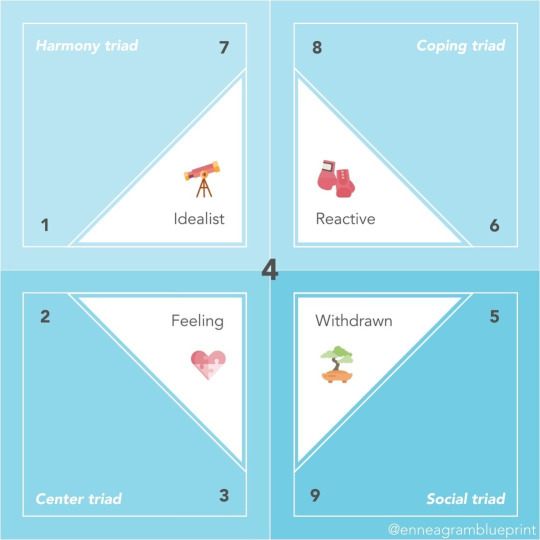
Triads: Enneagram 4
5 notes
·
View notes